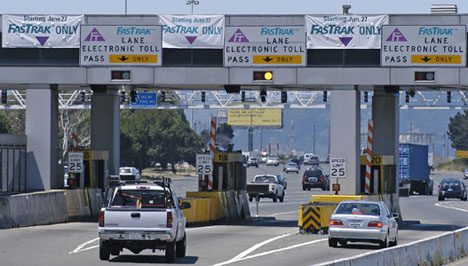The travel forecast just turned brighter for transbay drivers who want to keep their cash in their pockets — and their foot on the accelerator — by paying bridge tolls electronically with FasTrak®.

By John Goodwin
Published: July, 2006
The Bay Area Toll Authority (BATA), in late June, approved a comprehensive two-year plan to expand and improve the region’s electronic toll collection system by converting more lanes at bridge toll plazas to FasTrak®-only lanes; improving marketing and distribution of FasTrak® toll tags; and testing new technologies to improve operating efficiencies at the region’s toll plazas.
BATA, an arm of the Metropolitan Transportation Commission (MTC), has developed a plan to improve the operating efficiency of the toll plazas at the Bay Area’s seven state-owned bridges. The plan aims to boost the share of motorists who use FasTrak® to pay their tolls to 70 percent during peak commute periods and 50 percent on weekends.
A FasTrak®-only lane can handle about three times as many vehicles per hour as lanes where drivers stop to pay cash. Drivers in these special lanes often can bypass jams and enjoy a faster trip across most bridges. While FasTrak®-equipped vehicles already account for about 70 percent of morning commute traffic on the Golden Gate Bridge, the current figure for state-owned bridges during peak periods is just 42 percent.
Signing Up Simplified
To make FasTrak® more accessible and simplify the process for obtaining toll tags, the FasTrak® Strategic Plan lowers initial costs and establishes a retail distribution network.
Beginning this September, the initial prepaid toll balance for customers who open their accounts with a credit card will drop to $25 from the current $40, and the refundable toll tag deposit required for those who do not open their account with a credit card will dip from $30 to $20. No deposit is required from customers who use a credit card to open their accounts and request no more than three toll tags.
To get FasTrak® toll tags into more drivers’ vehicles right away, BATA is expecting to distribute toll tags at select retail locations beginning sometime in September.
More Dedicated FasTrak® Lanes
To accommodate 70 percent FasTrak® usage, BATA will team up with Caltrans in April 2007 to convert two more lanes at the Bay Bridge toll plaza, as well as two more at both the Carquinez and San Mateo-Hayward bridges, and one more at the Dumbarton and Richmond-San Rafael bridges, to FasTrak®-only lanes. The FasTrak® Strategic Plan also calls for three lanes of open-road tolling (allowing motorists to pass through the toll facility at highway speeds using their FasTrak® toll tags) at the new Benicia-Martinez Bridge toll plaza when the crossing’s new span opens in late 2007.
The conversion of more cash lanes to FasTrak®-only will be accompanied by lane striping and signage improvements to separate FasTrak® traffic from cash toll payers as far in advance of the toll plazas as possible.
In addition, the Strategic Plan calls for FasTrak®-only lanes to be grouped together at the left side of the toll plazas to the extent feasible, with cash lanes to the right side of the toll plazas and plaza approaches. According to Rod McMillan, director of Bridge Oversight and Operations for MTC, Directing traffic to the correct lanes well before the toll plaza is critical. We want to prevent traffic in the slower-moving cash lanes from interfering with FasTrak® customers. So we’ll be installing signs directly over the lanes, and extending the pavement striping for FasTrak®-only lanes as far upstream as we can to provide the maximum possible advantage for vehicles using FasTrak®.
Planned signage improvements include the use of changeable message signs at the toll plazas and along the approaches. This will allow the flexibility to increase or decrease the number of FasTrak®-only lanes as needed.
Half Million Strong and Growing
FasTrak® can be used in every lane at every toll plaza at every Bay Area toll bridge. There currently are more than 500,000 FasTrak® accounts open throughout the Bay Area. Traffic analysis done by MTC and Caltrans indicates that if more toll lanes are converted to FasTrak®-only and FasTrak® enrollment does not increase, cash tollpayers could face significant additional delay at toll plazas.
The projected delays in the cash lanes can be avoided if enough people switch to FasTrak®, explained McMillan. So we’re urging all motorists to sign up for FasTrak®. It’s easy and quick, there’s no charge for the toll tag, and there are no monthly maintenance fees.
Customers can enroll in FasTrak® online at 511.org or bayareafastrak.org, or via phone by calling 511 and asking for FasTrak® at the first prompt, or in person at the FasTrak® Customer Service Center at 475 The Embarcadero in San Francisco. A complete list of the planned lane conversions — and diagrams of the planned lane configurations at each toll plaza — is available on the BATA Web site at www.bata.mtc.ca.gov.

